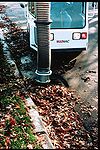
Difference between revisions of "Industrial prevention practices for TSS"
(Created page with "<font size=3>'''Industrial prevention practices for TSS'''.</font size><br> Link to this table <table class="sortable"> <tr> <th>P...") |
m |
||
| (3 intermediate revisions by the same user not shown) | |||
| Line 7: | Line 7: | ||
<th>Relative effectiveness</th> | <th>Relative effectiveness</th> | ||
<th>Method</th> | <th>Method</th> | ||
| − | <th>Image</th> | + | <th>Image<sup>1</sup></th> |
</tr> | </tr> | ||
<tr> | <tr> | ||
| Line 22: | Line 22: | ||
</tr> | </tr> | ||
<tr> | <tr> | ||
| − | <td>Material Storage Control | + | <td>Material Storage Control</td> |
<td>High</td> | <td>High</td> | ||
<td>Reduce or eliminate spill and leakage loss by properly inspecting, containing, and storing hazardous materials and having a cleanup plan that can be quickly and efficiently implemented.</td> | <td>Reduce or eliminate spill and leakage loss by properly inspecting, containing, and storing hazardous materials and having a cleanup plan that can be quickly and efficiently implemented.</td> | ||
| Line 28: | Line 28: | ||
</tr> | </tr> | ||
<tr> | <tr> | ||
| − | <td>Better Parking Lot Cleaning | + | <td>Better Parking Lot Cleaning</td> |
<td>High</td> | <td>High</td> | ||
<td>Maintain streets and parking lots frequently and especially in the spring by sweeping, picking up litter, and repairing deterioration; pressure wash pavement only as needed and avoid using cleaning agents.</td> | <td>Maintain streets and parking lots frequently and especially in the spring by sweeping, picking up litter, and repairing deterioration; pressure wash pavement only as needed and avoid using cleaning agents.</td> | ||
| Line 34: | Line 34: | ||
</tr> | </tr> | ||
<tr> | <tr> | ||
| − | <td>Proper Vehicle Management | + | <td>Proper Vehicle Management</td> |
<td>High</td> | <td>High</td> | ||
<td>Ensure that vehicles are fueled, maintained, washed and stored in a manner that prevents the release of harmful fluids, including oil, antifreeze, gasoline, battery acid, hydraulic and transmission fluids, and cleaning solutions.</td> | <td>Ensure that vehicles are fueled, maintained, washed and stored in a manner that prevents the release of harmful fluids, including oil, antifreeze, gasoline, battery acid, hydraulic and transmission fluids, and cleaning solutions.</td> | ||
| Line 46: | Line 46: | ||
</tr> | </tr> | ||
<tr> | <tr> | ||
| − | <td>Better Impervious Surface Deicing | + | <td>Better Impervious Surface Deicing</td> |
<td>Moderate</td> | <td>Moderate</td> | ||
<td>Properly store and conservatively apply salt, sand, or other deicing substances in order to prevent excessive and/or unnecessary contamination; implement anti-icing and prewet salt techniques for increased deicing efficiency.</td> | <td>Properly store and conservatively apply salt, sand, or other deicing substances in order to prevent excessive and/or unnecessary contamination; implement anti-icing and prewet salt techniques for increased deicing efficiency.</td> | ||
| Line 52: | Line 52: | ||
</tr> | </tr> | ||
<tr> | <tr> | ||
| − | <td>Better Turf Management | + | <td>Better Turf Management</td> |
<td>Moderate</td> | <td>Moderate</td> | ||
<td>Ensure that mowing, fertilization, pesticide application, and irrigation are completed in ways that will prevent or reduce grass clippings, sediment, and chemicals from entering storm sewer systems; use native vegetation where possible.</td> | <td>Ensure that mowing, fertilization, pesticide application, and irrigation are completed in ways that will prevent or reduce grass clippings, sediment, and chemicals from entering storm sewer systems; use native vegetation where possible.</td> | ||
| Line 58: | Line 58: | ||
</tr> | </tr> | ||
</table> | </table> | ||
| + | <font size=1><sup>1</sup> [[Pollution prevention#Photo credits|Photo credits]]</font size> | ||
| − | <noinclude>[[ | + | <noinclude> |
| + | [[Category:Level 3 - General information, reference, tables, images, and archives/Tables/Pollution prevention and source control]] | ||
| + | </noinclude> | ||
Latest revision as of 16:29, 3 August 2022
Industrial prevention practices for TSS.
Link to this table
| Practice | Relative effectiveness | Method | Image1 |
|---|---|---|---|
| Temporary Construction Sediment Control | High | Implement and encourage practices to retain sediment within construction project area; see Temporary Construction Erosion and Sediment Control Factsheets for additional information | |
| Wind Erosion Control | High | Institute a local program for wetting of open construction surfaces and other sources for windblown pollutants. | |
| Material Storage Control | High | Reduce or eliminate spill and leakage loss by properly inspecting, containing, and storing hazardous materials and having a cleanup plan that can be quickly and efficiently implemented. | |
| Better Parking Lot Cleaning | High | Maintain streets and parking lots frequently and especially in the spring by sweeping, picking up litter, and repairing deterioration; pressure wash pavement only as needed and avoid using cleaning agents. | |
| Proper Vehicle Management | High | Ensure that vehicles are fueled, maintained, washed and stored in a manner that prevents the release of harmful fluids, including oil, antifreeze, gasoline, battery acid, hydraulic and transmission fluids, and cleaning solutions. | |
| Storm Sewer System Maintenance | High | Regularly clean debris from storm sewer inlets, remove sediment from catch basin sumps, and remove any illicit connections to storm sewer systems. | |
| Better Impervious Surface Deicing | Moderate | Properly store and conservatively apply salt, sand, or other deicing substances in order to prevent excessive and/or unnecessary contamination; implement anti-icing and prewet salt techniques for increased deicing efficiency. | |
| Better Turf Management | Moderate | Ensure that mowing, fertilization, pesticide application, and irrigation are completed in ways that will prevent or reduce grass clippings, sediment, and chemicals from entering storm sewer systems; use native vegetation where possible. |
This page was last edited on 3 August 2022, at 16:29.







